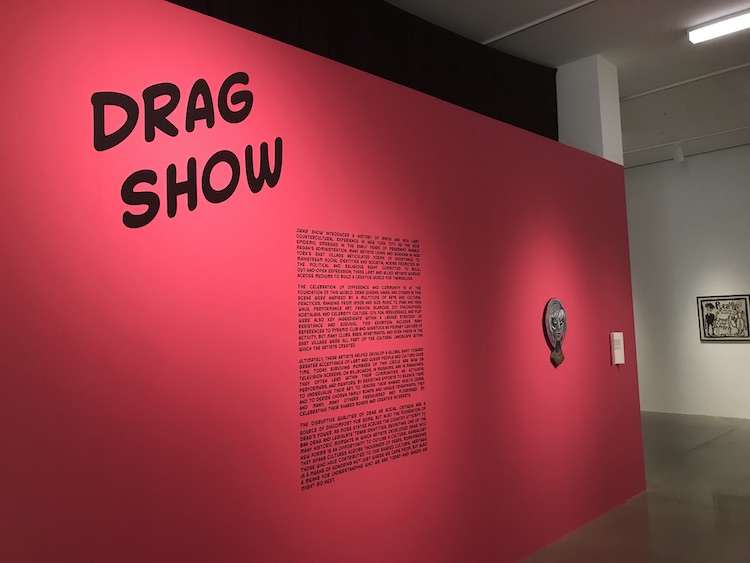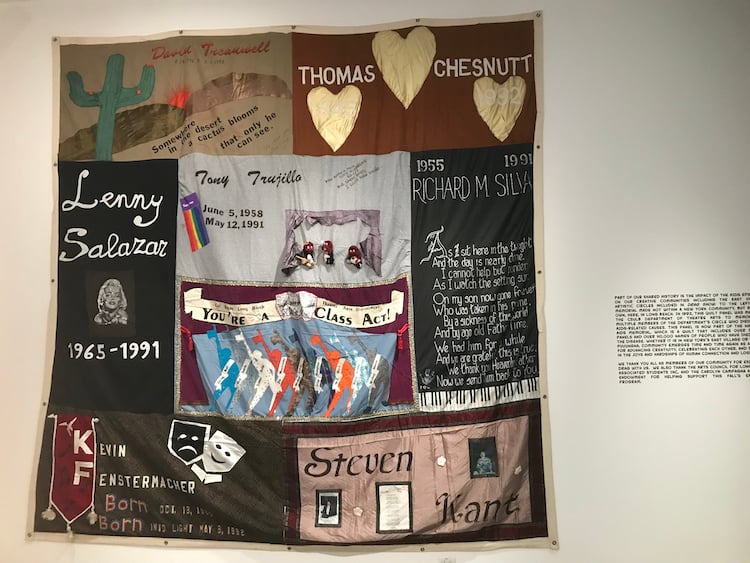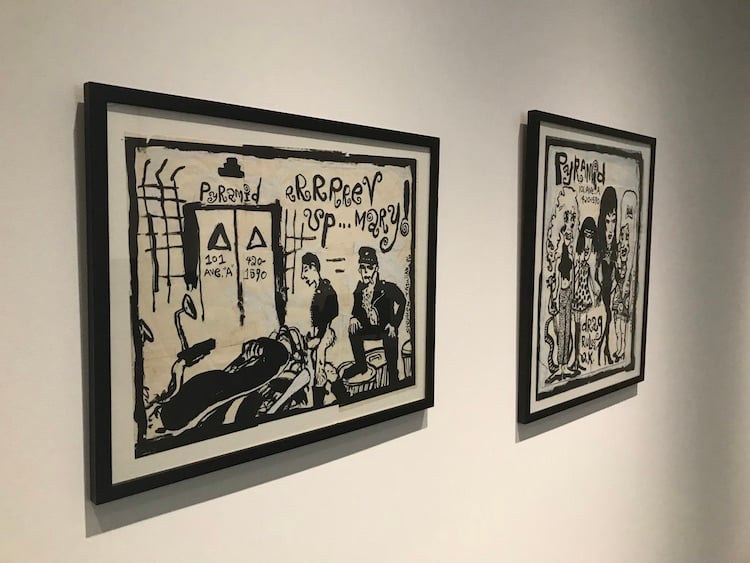
The “Drag Show” exhibit at Cal State Long Beach’s art museum showcases New York City’s underground and pioneering gay, drag, and transgender cultures from the 1980s. Photos: Q Voice News
The “Drag Show” exhibit at Cal State Long Beach’s art museum showcases New York City’s underground and pioneering gay, drag, and transgender cultures from the 1980s.
The “Drag Show” exhibit reflects rich and important gay and trans moments in the nation’s cultural history and explores how drag, a performance art, was and continues to be a powerful political tool that fosters resilience, joy, and irreverence.
“All of the work in the exhibit is about either being responsive to what our community is asking for, or filling in some scholarly gaps, particularly straight Americans’ understanding of LGBTQ history,” Paul Baker Prindle, director of Cal State Long Beach’s Carolyn Campagna Kleefeld Contemporary Art Museum, said.
Diedrick Brackens talks textile art, intersections of black and queer identities
The “Drag Show” idea started in the late spring/early summer, about the time the U.S. Supreme Court, led by the conservative majority, ruled that an evangelical Christian web designer can refuse services to same-sex wedding websites.
The exhibit idea also coincided with the surge in state legislators across the nation proposing and/or passing laws targeting the LGBTQ community, particularly trans people, Prindle said.
New York drag, gay scene in 1980s
As the AIDS epidemic emerged in the early years of President Ronald Reagan’s administration, many LGBTQ+ artists living and working in New York’s East Village pushed back against mainstream social identities and societal norms promoted by the political and religious right.
They smashed “the closet.” They were committed to bold, out-and-open expression,and worked in various mediums to build a creative world for themselves.
They refused to be silenced and spoke out about their shared health crisis in battling AIDS.

A section of the AIDS Memorial Quilt, the world’s largest ongoing community folk art project, is part of the exhibit. It celebrates the lives of people who have died of AIDS-related causes. This block includes panels made in Long Beach, including one created by the Cal State Long Beach Theatre Department to memorialize people affiliated with the department who died.
Inspirations
Drag queens, kings, and others in the scene were inspired by a range of arts and cultural practices,
ranging from 1950s and 1960s music to punk and New Wave, performance art, fashion, glamour, do-it-yourself philosophies, nostalgia, and celebrity culture.
Joy, fun, irreverence, and play were also key ingredients to resistance and survival.
“Drag Show” includes many references to Pyramid Club and Wigstock, which were some of the primary centers of LGBTQ+ artistic activity in the East Village.
The exhibit showcases several artists (Nan Goldin, Mark Morrisroe, Jack Pierson, Tom Rubnitz, Linda Simpson, Tabboo!, and David Yarritu) and a variety of mediums, including photography, drawings, videography, and zines.
Separate solo exhibitions spotlight Pau S. Pescador and Félix González-Torres. Those exhibits are a prologue to “Drag Show.”
Pau S. Pescador
Pescador is a contemporary trans-nonbinary artist who works in film, photography, and performance. These photographic collages center on Pescador, who breaks down the process of shifting their physical appearance as a trans non-binary person in images that are simultaneously documentation and abstraction, dancing with cultural signifiers of identity.
Félix González-Torres
A Cuban-American artist whose life was caught short by AIDS-related causes, Gonzalez-Torres’ works often place the viewer as an integral element in the meaning he communicates.
In “Untitled (L.A.), 1991,” viewers are invited to take a piece of candy from the spills, completing an exchange between the artist and viewer. But it’s more than candy as a material to be shared.
As visitors take pieces of candy, the shrinking dimensions of the spill function as a metaphor for a body ravaged by AIDS wasting syndrome.
Here are highlights from the “Drag Show” exhibit at Cal State Long Beach, which runs through Dec. 15.
Tom Rubnitz
A painter, video artist, and drag artist, Rubnitz was a member of the East Village creative set whose groundbreaking art crossed many disciplines.
Rubnitz’s work was often particularly irreverent. His 1989 video “Pickle Surprise,” featuring Lady Bunny and RuPaul in a cooking show sketch, went viral and. The performers learn how to make a ham sandwich from a genie dressed as a pickle. When RuPaul asks, “Where’s the pickle?” Lady Bunny giggles and replies, “That’s the surprise!”
“For fans of ‘RuPaul’s Drag Race,’ Rubnitz’s lasting impact on comedy and camp queen drag is evident in the recurring video challenges RuPaul gives contestants each season,” Prindle said.

Tabboo!, also known as Stephen Tashjian, is a central figure in the exhibition. He was influential in the East Village art scene, including designing advertisements, posters, and flyers for the Pyramid Club. “The Pyramid Club was really a center of drag culture and gay culture in New York in the 1980s,” Paul Baker Prindle, director of Cal State Long Beach’s Carolyn Campagna Kleefeld Contemporary Art Museum, said. “It was a catalyst. Drag as we know it today for most people was really filtered through the Pyramid Club.”
Tabboo!, Pyramid Club
Tabboo!, also known as Stephen Tashjian, is a central figure in the exhibition. He was influential in the East Village art scene, including photography, painting and drawing, drag, hosting at the Pyramid Club, and designing advertisements, posters, and flyers for the Pyramid Club.
“The Pyramid Club was really a center of drag culture and gay culture in New York in the 1980s,” Prindle said. “It was a catalyst. Drag as we know it today for most people was really filtered through the Pyramid Club.
“What’s so fascinating about the Pyramid Club is that it actually wasn’t a gay bar,” Prindle said. “They just had gay nights. It was a live performance and music venue. Nirvana played there. That’s actually how RuPaul and Kurt Cobain became friends.”
AIDS Memorial Quilt
A section of the AIDS Memorial Quilt, the world’s largest ongoing community folk art project, is part of the exhibit. It celebrates the lives of people who have died of AIDS-related causes.
Started in 1987, the quilt has more than 50,000 3-foot by 6-foot panels that are individually sewn together into 6,000 12-foot by 12-foot block sections. In its entirety, the quilt weighs more than 54 tons and encompasses 1.5 million square feet of fabric.
The quilt is a source of remembrance, healing, and hope. In each panel, the names and stories of more than 110,000 friends, family members, and loved ones are sewn.
In the U.S, 700,000 people have died from AIDS-related causes.
More than 40 years into the AIDS pandemic, more than 1.2 million people live with HIV in the U.S.
This block includes panels made in Long Beach, including one created by the Cal State Long Beach Theatre Department to memorialize people affiliated with the department who died.
